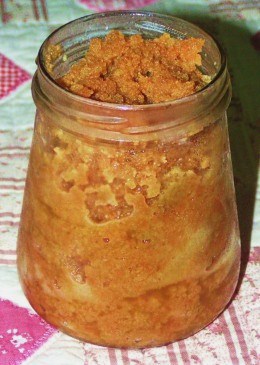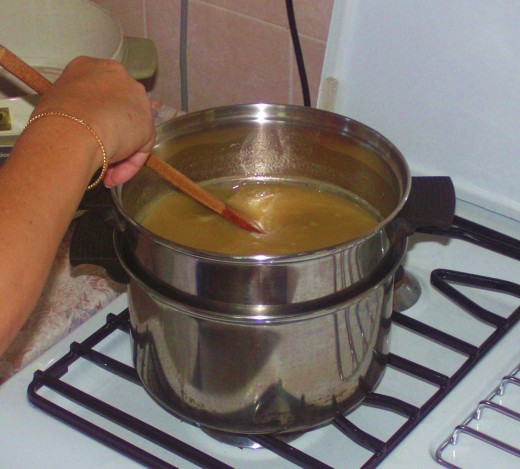Kaya : Coconut Milk Egg Custard Jam Recipe
Kaya (Coconut Jam)

Kaya : coconut milk egg custard jam
Kaya is a local Malaysian “jam”. It is taken just like any of your jams which you spread on your bread. Should we call it a type of sandwich spread, then? Kaya or Sri Kaya (or Seri kaya) is very popular in Southeast Asia, especially Thailand, Malaysia and Indonesia. The Philippines also has its own version of kaya. “Kaya” literally means “rich” in the Malay and Indonesian languages. Most probably because of its “golden” color.
I think the most suitable name for kaya in English would simply be “coconut jam”. However, to fully describe the kaya, it has to be called “coconut milk egg custard jam”, as the main ingredients are coconut milk and eggs. The finished product looks like creamy custard.
The taste of the kaya is very sweet and aromatic. Very sweet because a typical recipe will call for more than ample amount of sugar. Of course the sugar quantity may be reduced to taste. The creamy consistency and texture come from the coconut milk, sugar and eggs. The resulting color of the kaya will depend on the quantity of the pandan leaves used and the amount of caramel. Pandan is screwpine. The color varies from golden yellow, greenish, to dark brown. The consistency and texture of the kaya vary, depending not only on the ingredients, but also on the skill and patience in stirring during the process. It also depends on the preference of the person preparing it.
The commercially produced kaya will have a very smooth consistency giving a more pleasant sight and easier to spread on the bread. They have added corn flour. My recipe is mainly for taste and not on appearance. As you can see from the photo, my kaya is slightly more "lumpy and rough", That is the way I like my kaya. You can't buy this type of kaya from the shops, as it simply doesn't appear appetizing and a bit messy to spread. It is not commercially viable. But believe me, the taste of my kaya is way above the commercial product.
Eggs in the bowl

Pandan (screwpine) leaves

Coconut Milk (santan)

Ingredients mixing in the mixer

Patiently stirring the mixture

Kaya steaming in the double-boiler

The final product : Kaya


Kaya recipe
As with jams, there are many different recipes for kaya, but the main ingredients remain the same.
Ingredients:
1. Eggs : 10 (average size)
2. Sugar : 1 bowl (the size that holds the 10 eggs)
3. Santan (coconut milk) : 1 bowl (same size)
4. Butter (optional) : 80 gm
5. Pandan leaves (screwpine) : tie up 5 big leaves, crush or scratch with fork to release the juice
6. Extra 2 tablespoons sugar for caramel
Methods:
Step 1. Put all the ingredients from 1 to 4 into a mixer to mix thoroughly.
Step 2. Transfer ingredients to the upper pot of a double-boiler.
Step 3. Put in the pandan leaves.
Step 4. First boil the water in the lower pot of the double-boiler.
Step 5. When water is boiling, put the upper pot in, and start to stir the mixture.
Step 6. Continue to stir until the mixture becomes pasty. This will take half to an hour.
Step 7. Cover the pot with the lid. The lid must be covered with a few layers of muslin or cotton cloth.
Step 8. Turn heat to low, and steam for 4 hours.
Step 9. Prepare caramel. Heat the 2 tbsp sugar in a small pot until caramelized.
Step 10. Pour into the kaya mixture and stir to mix thoroughly.
Step 11. Cover the pot and continue steaming for another 15 minutes.
When cool, transfer the kaya to containers and keep in fridge.
Kaya goes very well with butter on toast, which we call the “yin-yang” style, representing the two opposing colors of the Chinese “yin-yang” emblem. This is basically a breakfast item, but kaya can be taken any time of the day. Kaya can also be used as a delicious spread on crackers (biscuits).
If you find this kaya recipe to be too exotic and procedure too long and tedious, you may like to try my other more down to earth orange marmalade recipe.
The "yin-yang" spread


Link to my other interesting and beneficial articles
If you find this article interesting or beneficial, you may go to my "Profile" page to read my other articles by simply CLICKHERE:
By the way, the copyright to this article is owned by Good Guy. Please do not “copy and paste”! Thank you.









